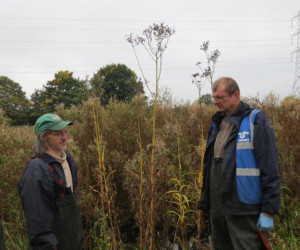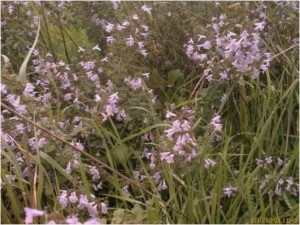The latest e-mail from the Kent Botanical Recording Group, which is producing a comprehensive register of rare plants in the county (which in this case includes that part of west Kent that is now in Greater London) called for information about ongoing work designed to conserve these species in the area. This has prompted me to put together a quick report on what is happening in Bexley. If anyone has news of other such initiatives in our Borough, please let us know.
The Kent list is here, but it should be noted that some of the plants on it are listed due to significant declines though they may not yet be absolutely rare, and there are a number of other species in Bexley that are rare in London but not the administrative county of Kent:
http://bsbi.org.uk/rare_plant_register_list_v9_with_English_names.rtf
Asterisked plants below are on the Kent list. Others are uncommon in London, for which there isn’t an official rare plants list at present and /or Bexley.
Thames Road Wetland hosts a number of species that are nationally, regionally or locally scarce. The following species are being actively encouraged and sometimes ‘weeded’ around:
– Marsh Sow-thistle* – This is a nationally scarce species. Plants were introduced to the site that had been grown from seed off the since extirpated Crayford Marshes colony, the last in London, saved by BMNH botanist Mark Spencer. Further plants have been grown from TRW-harvested seed and there are now plants at Crossness (Erith Marshes), Deptford Creek and the London Wetland centre. I fear the conditions required for natural regeneration, probably creation of exposed areas of wet bare mud that persist for a few years, are lacking in at least two of the current introduction locations. In other words, the species has probably suffered from the way we have hemmed in our rivers and drained the marshes.
– Brookweed – mainly a matter of putting some cut Bramble stems over them in winter to try and limit the Horse trampling (which is otherwise conducive to their survival). Have propagated some plants from seed and put in a new location on the site. Along with plants on private land on Crayford Marshes, this may be one of only 2 colonies inside the London boundary.
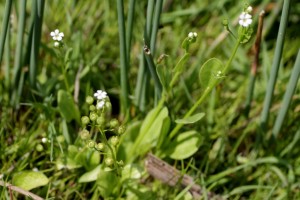
The Primula relative Brookweed (Samolus valerandi), a very rare plant in London, growing at Thames Road Wetland. (Photo: Martin Petchey).
– Dittander*
– Square-stemmed St. John’s-wort
– Hop Sedge (Carex pseudocyperus)
– Mistletoe (London Species Action Plan) – protection from the risk of people picking it after the Poplar trunk it’s on got blown down, but has somehow stayed alive despite now limited attachment to the base of the tree.
– Common Cudweed* came up a couple of years ago but hasn’t been seen since.
Lesnes Abbey Woods
– Lesser Calamint* – this is managed by Lesnes Abbey Conservation Volunteers at its one site in London near the abbey ruins. Mainly involves taking out excessive bramble growth.
– Small Teasel* is also found scattered in the eastern part of the woods, the only place in the Borough where it appears to have been recorded. One of the best clumps was destroyed by the Council dumping a big pile of cut tree branches on it, which is par for the course really.
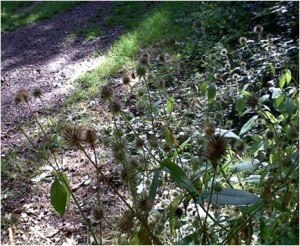
Small Teasel (Dipsacus pilosus) grows in Lesnes Abbey Woods, the only place where it is found in Bexley. (Photo: Chris Rose)
– Climbing Corydalis is uncommon in London and has 2 sites in Bexley, Lesnes and Bursted Woods, where action is taken to prevent it getting too overrun with Bramble, which it otherwise likes to climb into.
– The heathland area is managed by LACV to maintain Heather* by weeding out tree seedlings and bracken. Elsewhere Holly and bramble etc. are thinned out to favour the native Narcissus.
Martens Grove
– Slender St. John’s-wort – has disappeared from most Bexley Woods due to lack of coppicing. A few plants found in Martens Grove. I have scattered some seed a bit more widely to reduce risk of accidental destruction of the whole colony.
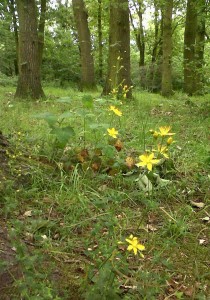
Slender St. John’s-wort (Hypericum pulchrum) has vanished from several local woods, but seedlings are doing well at Martens Grove. (Photo Chris Rose)
Bexley Park Woods
– Common Cow-wheat – Has also been recorded in Chalk Wood, and in Joydens Wood (though said to have been outside the London boundary). Another species that has been lost elsewhere due to lack of coppicing. We are trying to get a Friends group going there to help this and other things survive, including Sanicle*.
Braeburn Park, now managed by the London Wildlife Trust, has a number of species uncommon in Kent and/or London/Bexley, that will benefit from the thinning of Buddleia scrub that is taking place, and ongoing Rabbit grazing, such as Wild Basil, Yellow Vetchling* and Long-stalked Crane’s-bill.
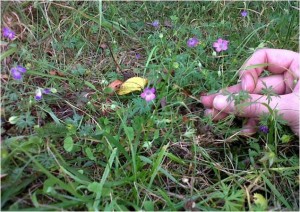
Long-stalked Crane’s-bill (Geranium columbinum) was discovered at Braeburn Park by Chris Rose, and is the only known site for it in the Borough of Bexley. (Photo: Chris Rose)
Miscellaneous sites
– Catmint* (Nepeta cataria) – I found this on a garage forecourt by its prices sign in Long Lane, Bexleyheath. It would appear to be the only recent record in Bexley. There is one from Braeburn Park, but the garden Catmint also used to occur there. It has since been killed off at the garage but I had collected seed and it now self-sows in my garden, where it is a short-lived perennial, and I also have a couple of plants on my allotment now.
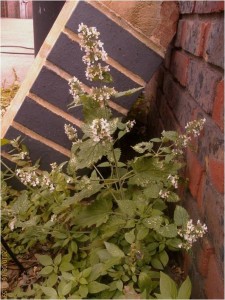
The true native Catmint (Nepeta cataria) found on the forecourt of a garage in Long Lane, Bexleyheath. (Photo: Chris Rose)
– My allotment site in Barnehurst also has Corn Spurrey*, which puts on a big show every now and again – ‘management’ is a matter of ordinary allotment cultivation and the fact the plants don’t all get weeded out.
– Devil’s-bit Scabious* was found by me in a small cemetery in Northumberland Heath a couple of years ago. Bexley Natural Environment Forum has got this site recommended for addition to the Council’s list of SINCs. Has also been recorded at Footscray Meadows in the past.
– Harebell* – BNEF got the churchyard at Christchurch Bexleyheath where this hadn’t previously been recorded, listed as a SINC. The current regime could be tweaked to allow more flowers but we haven’t had time to talk to the relevant authorities. The site also contains Trailing St. John’s-wort, one of two known sites for this in Bexley.
– Hoary Cinquefoil (Potentilla argentea)* – Mark Spencer, co-ordinator of the new London Flora project, thinks this could soon become extinct in London. One plant I found in the rock garden beds at Hall Place getting smothered by Bindweed got weeded out by the look of it, but in 2014 I found another in mown grass nearby. There is more in a private front garden lawn on the Bexleyheath/Blackfen border.
– Sainfoin* persists in the ‘meadow’ in the Hall Place flood overflow basin, due to summer mowing by the Council. May have originally been sown.
– Black Poplar is in trouble nationally, not least because it hybridises with introduced Poplars. Bexley Council has planted some Black Poplars in the north of the Borough.
Some plants on the Kent rare list, and that are uncommon in London, are secure enough without special attention at present, such as Strawberry Clover* at Crossness and Clustered Clover (Trifolium glomeratum)* which is common on local golf courses and even some roadside grass verges in central Bexleyheath.
Flixweed* is a species that pops up randomly and then vanishes again. I have found it at 4 locations in Bexley over the last 5 years, but at only one did it appear a second year.
– A couple of Ragged Robin* appeared by a pond in Danson Park last year after it was dredged. We will have to see if it persists.
– Golden Dock* appeared in Marlborough Park in Sidcup by the River Shuttle 2-3 years ago and Geoffrey Kitchener, an expert in the genus confirmed the ID. Not seen since. Insufficient bare mud I suspect.
At some point a Bexley rare plant list ought to be produced, but for now we can see once again that the Borough is still a fantastic place for wildlife, but can only remain so if the concrete merchants can be kept at bay.
Chris Rose, Vice-chair Bexley Natural Environment Forum / Thames Road Wetland Site Manager / LACV / KBRG member.

